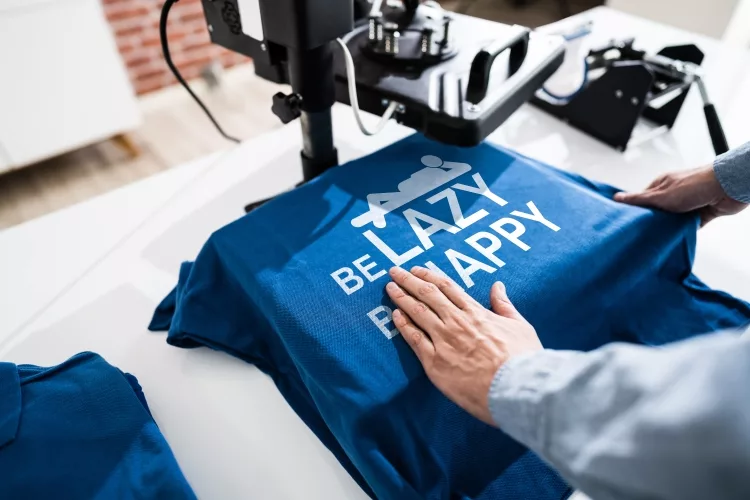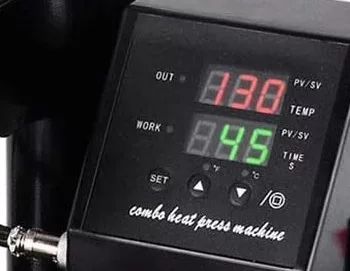Beginners Guide for Heat Press Temperature and Time Settings
by Anthony Clark
One of the most effective printing methods on materials is using heat press machines since the finished result is typically immaculately clean. For their widespread usage, they may be utilized to create a huge number of prints in a very short amount of time. Occasionally, however, that isn't always the situation. If you are involved in the printing industry, you will support that you have had a few unpleasant encounters with printers.
Maybe the artwork wasn't coming out as good as it should have, or maybe the design wouldn't adhere to the surface well enough. This may be a huge hindrance, particularly if you just started the work. Very low or very high temperatures could also be the cause of this. However, the fact is that various kinds of cloth require various time settings and temperatures. There is no standard temperature for every fabric. Fortunately, there is a compilation of temperature chart and heat press time guide for few of the most common clothing materials used with the machine to assist you to prevent these problems.
Contents
- Temperature Chart for Heat Press
- Using a Heat Press Machine, Learn How To Program the Time and Temperature Settings
- Recommended Time and Temperature Range
- Fabric made of polyester or sublimated polyester
- Vinyl
- Cotton
- Vintage
- Full-color printing
- Glitters
- Digital prints of superior quality
- Reflective fabrics
- Glowing fabrics
- Stubborn fabrics
- Metallic finish
- Transfer of design to light-colored material
- Transfer of design to dark-colored material
- Multi-purpose material
- Conclusion
Temperature Chart for Heat Press

| Material | Temperature |
| Polyester | 270° F |
| Cotton | 380°F |
| Stretch material | 335°F |
| Vintage | 350°F |
| Full color | 350°F |
| Glitters | 350°F |
| High-quality digital prints | 305°F |
| Reflective fabrics | 305°F |
| Glow in the dark fabrics | 350°F |
| Stubborn fabrics | 330°F |
| Metallic finish | 320°F |
| Photo transfer on light fabrics | 385°F |
| Photo transfer on dark fabrics | 356°F |
| Multi-purpose material | 350°F |
Using a Heat Press Machine, Learn How To Program the Time and Temperature Settings
Most heat presses include a manual to describe how to perform key tasks such as adjusting time or temperature. But the downside to this is that the manual may be lost or destroyed before you are able to read it. Also, in order to perfect the time and temperature, you will need to understand how to operate the settings correctly. As a result, we have chosen to provide a short description of what we mean.
Time frame setting

Setting the time on a computer is not hard at all. In most cases, a digital time display option is available, which may be adjusted by hitting either of the up and down arrow keys on the machine's keyboard. Though some feature a more conventional dial that may be adjusted by simply rotating it to the desired time, others are more innovative. Recently produced heat press machines include a self-off function that, when the timer expires, shuts the engine off or even opens the lid to allow the press to cool down. The time dial may be distinguished by the minute or second indication that appears next to the numerals.
Temperature setting
The temperature setting is quite similar to the time setting. The main contrast is that the dial now displays either a Celsius or a Fahrenheit symbol. It is quite similar to using an oven or a microwave in terms of functionality.
Guide to Using a Heat Press at the Correct Temperature and Time
The reliability and accuracy of transmission are affected by a number of variables, as we have already discussed. Time, pressure, and temperature are the variables to consider. When dealing with fabric, the values of these variables must be adjusted to the appropriate values for the fabric being transferred to ensure a proper transfer of the images.
Additionally, the values vary for textiles that are bright in color and dark in color. Darker colors are more suitable with higher temperatures, while lighter colors are more suitable with lower temperatures.
Before we proceed any further, we'd like to point out that using a shirt that is filthy or wrinkled may cause your transfer to be sloppy or perhaps impossible to complete. As a result, constantly make certain that the garment is clear of dirt, particularly oil stains. Also, make certain that the garment is ironed and free of wrinkles before putting it on.
Recommended Time and Temperature Range
Fabric made of polyester or sublimated polyester
This kind of cloth is very delicate and does not need a lot of heat to be worked with. When printing on it, it is critical that just a modest quantity of heat be used and that it does not remain in the machine for an extended period of time. The ideal temperature for this cloth is 270° F, and the ideal duration to dry it is ten seconds. Furthermore, when it is still hot is the ideal moment to peel the transfer. In our other post, we go into more depth on how to shrink polyester clothes quickly and efficiently.
Vinyl
Vinyl is the most straightforward and least costly material with which to begin using your heat press machine. Vinyl requires a higher temperature than polyester in order to get the optimum results, and vice versa. The optimum temperature for vinyl is 320 degrees Fahrenheit. Firm pressure should be applied to the machine for 10-15 seconds in order to get a bright and precise pattern. In fact, preheating the cloth before pressing it will result in a better print on your shirt than pressing it at room temperature. While scouring the market for vinyl, you may get perplexed as to whether to purchase the "series 31 vinyl" or the "series 51 vinyl."
There is, however, a clear distinction between the two of them.
- The series 51 has a gloss surface and is permanently adhered.
- The series 31 is renowned for its smooth surface and detachable adhesive, on the other hand, and this is a feature that many people like.
Cotton
Cotton is a fabric that is often used in the manufacturing of clothes. It is long-lasting and can resist high temperatures. When transferring to cotton material, the optimum temperature is 380°F, and the best duration is 15 minutes, according to the manufacturer. It is preferable to peel off while the skin is still warm.
Stretch material
It may be challenging to work with this kind of material. This is due to the fact that the printed design tends to stretch with the cloth, resulting in it seeming ragged. It is recommended that you operate the machine at 335°F for 10-12 seconds to produce the desired output. Wait for the cooling time before removing the transfer paper from the print.
Vintage
This provides the appearance of a faded, immaculate vintage look. It is a popular and one of the oldest fashion trends. It has been around for quite some time. It is necessary to print the pattern at 350°F for 10-12 seconds in order to do this. While the pattern is still hot, peel it away from the surface.
Full-color printing
Ensure to print your shirt at 350°f for 12 seconds to ensure that all of the colors are visible and that the intensity is ideal. Since the transfer is still warm, it will be easier to peel it away from the surface.
Glitters
Glitters are a textured pattern that contains flecks of sparkling material. It is not difficult to create if you follow the proper temperature and time specifications of 350°F for 15 seconds. Also, keep in mind that the garment should be removed while it is still warm.
Digital prints of superior quality
Preserve the quality of your transfer paper images while printing them digitally on the transfer paper. In order for this to occur, you will need to heat it to 305°F for about 5 minutes before transferring it. It is best to remove the graphics while the computer is still warm.
Reflective fabrics
This kind of pattern is most often seen on protective clothing. This is due to the fact that they have a reflecting surface. In order to do this transfer, you will need to get the appropriate transfer paper. Transferring at 305°F for 10-12 minutes is excellent, and the temperature should be maintained at that degree. When the skin is cold, it is easiest to pull it off.
Glowing fabrics
Children's nightwear and Halloween costumes tend to glimmer when the lights are turned out. This occurs when a fabric has been illuminated in the beginning and then placed in a dark environment after that exposure. Making this kind of transfer will also need the purchase of the appropriate transfer paper. The most suitable temperature to achieve the best outcome for this process is 350°F. 10-12 seconds should be enough for the work, and it should be peeled off before it cools down.
Stubborn fabrics
To put it another way, creating a transfer onto material like this one may be tough. It is for this reason that it is critical to set the time and temperature parameters correctly. We recommend that you utilize a temperature of 330°F for 15 minutes to get the best results. Additionally, pull it off while it is still hot.
Metallic finish
Some garment fabrics have a metallic sheen to them that gives them the appearance of being made of metal. All that is required is that you do a transfer at 320°F for 20 minutes to achieve this. Then it should be peeled off when the temperature has dropped.
Transfer of design to light-colored material
For achieving ideal image transfer to a light-colored cloth, it is required to operate at a temperature of 385°F for approximately 20-30 minutes. There is a more likely chance of getting a perfect finish by following these steps. While it is still hot, you can easily peel it off.
Transfer of design to dark-colored material
For graphic transfer to a dark-colored material, a higher temperature than the light-colored material is required. Operating at a temperature of 356°f for 25 minutes should be suitable for a good transfer. Peel off the transfer paper before it cools down.
Multi-purpose material
This kind of material can be applied to multiple cases. Using the heat of 350°f for 10-12 seconds will be required for a successful transfer.
Conclusion
For new practitioners, the entire process may seem difficult, but it can be simplified if written down in a book. Highlighting key areas will also help in fully grasping the process of the work. Nevertheless, for a successful transfer, the first step is obtaining the right materials. After that, the temperature and time can be adjusted. Persons following the instructions as stated in this article will have the best results.
 |  |  |  |

About Anthony Clark
Anthony Clark always had a passion for digital drawing and printing ever since he was young. He would wander around his parents' house in Phoenix, Arizona drawing various things with his older digital tablet. Be it just a memory collection or a portrayal of anything: objects, parents, school, events, etc. He received his BA in Graphic Design at San Jose State University - the heart of Silicon Valley. Now Mr. Clark is excited to present his experience coupled with some colorful dips to help shape the future of printing.
Thoughts on "Beginners Guide for Heat Press Temperature and Time Settings"
 |  |  |  |
Get some FREE Gifts. Or latest free printing books here.
Disable Ad block to reveal all the secret. Once done, hit a button below
 |  |  |  |